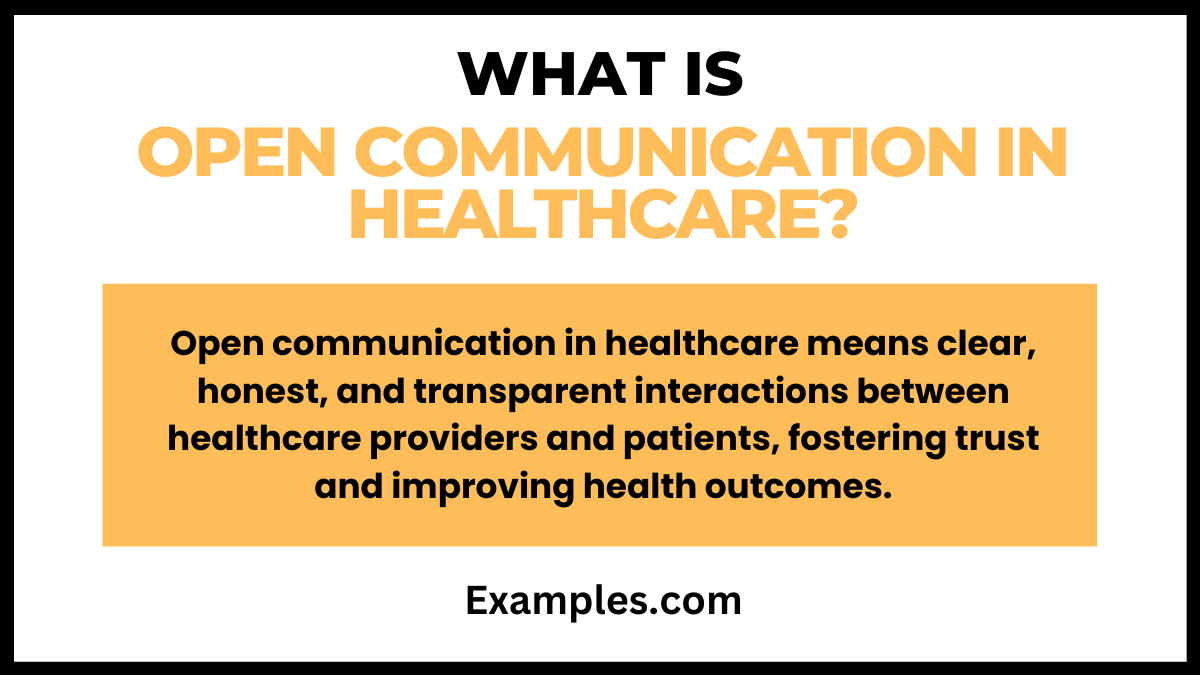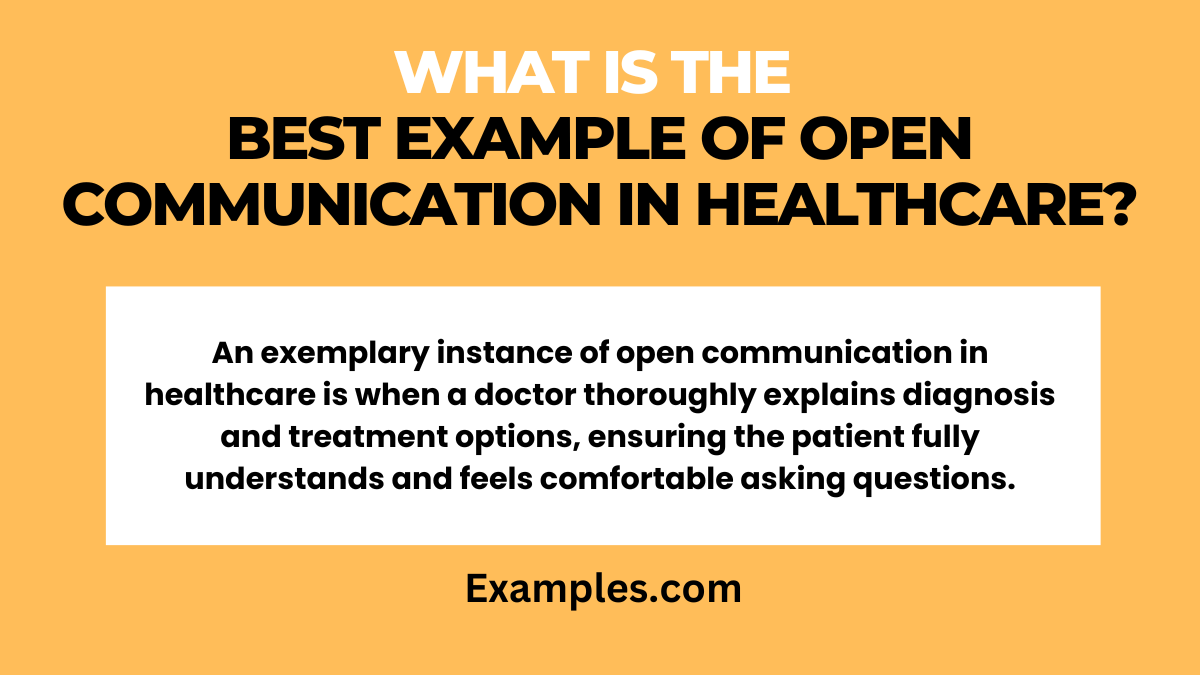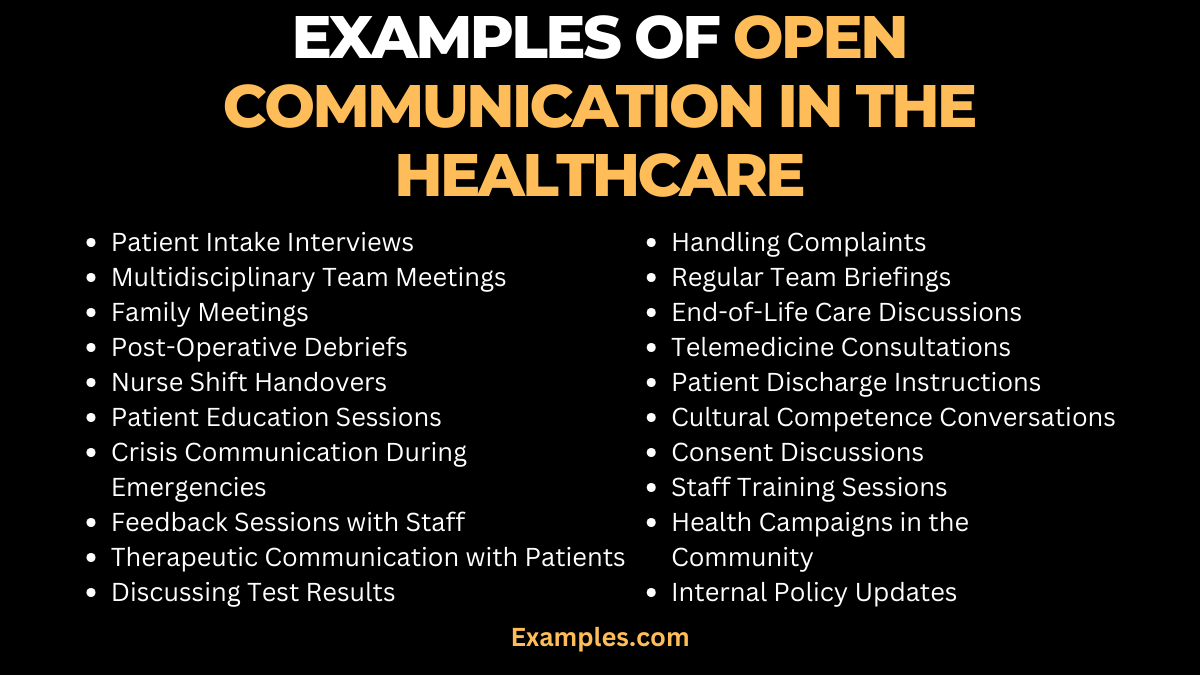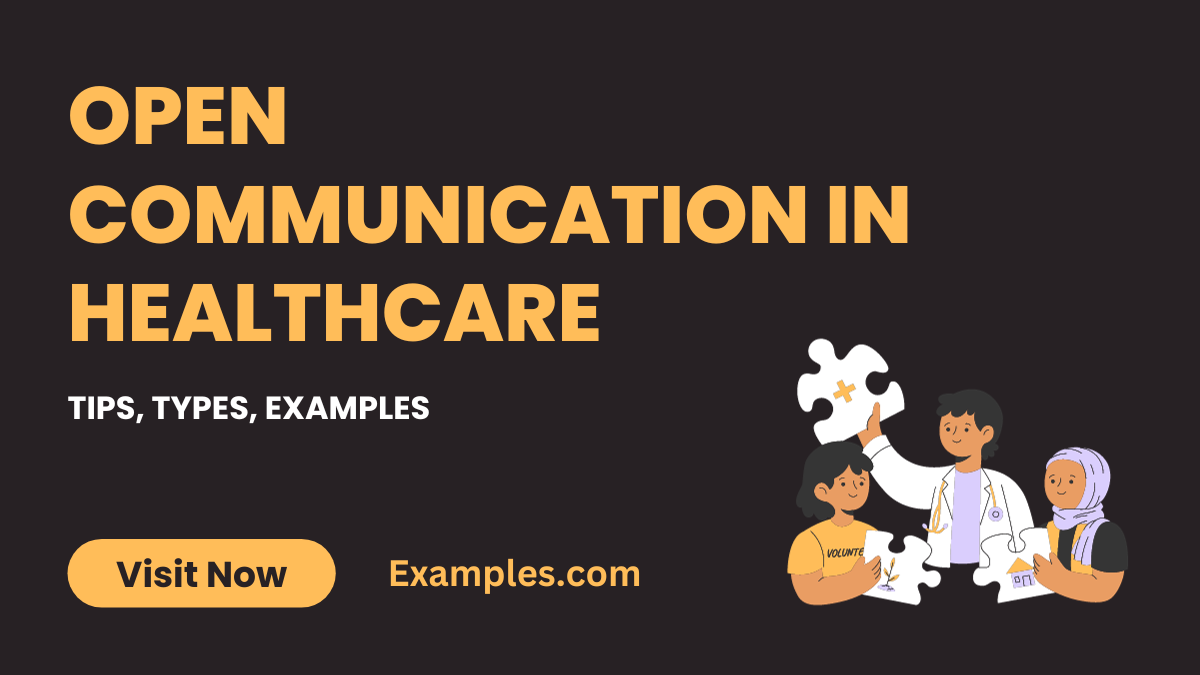19+ Open Communication in Healthcare Examples
In the dynamic realm of healthcare, open communication stands as a cornerstone, ensuring effective patient care and team coordination. This comprehensive guide delves into various communication examples in healthcare settings, highlighting their significance for patient safety and staff collaboration. From nurse communication strategies to overcoming communication barriers, we explore practical scenarios and solutions. Embrace the transformative power of open dialogue in healthcare, enhancing both patient outcomes and workplace harmony.
Download Open Communication in Healthcare in PDF
What is Open Communication in Healthcare? – Meaning

Open communication in healthcare refers to the clear, honest, and respectful exchange of information between all parties involved in patient care. It encompasses a range of communication skills, from verbal discussions to non-verbal cues and written documentation. This approach fosters a transparent environment where patients, healthcare providers, and staff feel comfortable sharing concerns, asking questions, and providing feedback. Such an atmosphere is crucial for accurate diagnosis, effective treatment plans, and ensuring patient safety. Open communication not only aids in addressing immediate health concerns but also builds trust and strengthens relationships within the healthcare setting.
What is the Best Example of Open Communication in Healthcare?

One of the best examples of open communication in healthcare is the collaborative dialogue between a patient and their healthcare team during a patient care conference. In this setting, a patient is actively involved in their care plan, with doctors, nurses, and other healthcare professionals openly discussing the patient’s condition, treatment options, and concerns. This type of communication for patient safety allows the patient to express their preferences and ask questions, ensuring they fully understand their health status and the proposed treatments.
Such open dialogue is essential in creating a patient-centered care approach. It not only empowers patients but also helps healthcare providers gain a comprehensive understanding of the patient’s needs and preferences, leading to more personalized and effective care. This example highlights the essence of therapeutic communication in healthcare, where the focus is on understanding and addressing the patient’s concerns as much as it is on the clinical aspects of their care.
20 Examples of Open Communication in Healthcare

Open communication in healthcare is vital for patient well-being and efficient healthcare delivery. This list provides 20 unique and distinct examples, demonstrating effective communication methods in various healthcare scenarios. From nurse communication to managing communication barriers, these examples offer insights into the practical application of open dialogue in medical settings.
Patient Intake Interviews
Healthcare professionals ask open-ended questions to understand the patient’s history and concerns.
Example: “Can you describe your symptoms in more detail?”
Multidisciplinary Team Meetings
Teams discuss patient care plans, ensuring everyone’s input is considered.
Example: “Let’s review the patient’s progress and adjust our approach accordingly.”
Family Meetings
Doctors explain patient conditions and treatment options to family members.
Example: “We want to ensure you understand the treatment plan and its potential outcomes.”
Post-Operative Debriefs
Surgeons provide detailed explanations of the procedure’s outcome to the patient.
Example: “The surgery went as planned, and here’s what you can expect during recovery.”
Nurse Shift Handovers
Nurses share patient information accurately during shift changes.
Example: “The patient in room 202 experienced discomfort, which we managed with prescribed medication.”
Patient Education Sessions
Educating patients about managing their conditions.
Example: “Let’s discuss how you can effectively manage your diabetes at home.”
Crisis Communication During Emergencies
Clear and calm communication in emergency situations.
Example: “We need to act swiftly; please follow my instructions carefully.”
Feedback Sessions with Staff
Encouraging staff to share their experiences and suggestions.
Example: “Your input is valuable; how do you think we can improve patient care?”
Therapeutic Communication with Patients
Addressing patient fears and anxieties.
Example: “It’s normal to feel anxious; let’s talk about your concerns.”
Discussing Test Results
Transparently discussing test outcomes with patients.
Example: “Your test results are back, and I’d like to go over them with you.”
Handling Complaints
Addressing patient or family complaints constructively.
Example: “I understand your concerns, let’s find a solution together.”
Regular Team Briefings
Keeping the healthcare team informed about updates.
Example: “In today’s briefing, let’s discuss the new protocols.”
End-of-Life Care Discussions
Compassionate conversations about end-of-life options.
Example: “We want to honor your wishes; let’s discuss your care preferences.”
Telemedicine Consultations
Effective remote communication with patients.
Example: “Can you tell me more about your symptoms since our last video call?”
Patient Discharge Instructions
Clear instructions for home care after discharge.
Example: “Here are your discharge instructions; let’s go through them together.”
Cultural Competence Conversations
Respecting and addressing cultural differences in care.
Example: “I’d like to understand more about your cultural needs and how we can accommodate them.”
Consent Discussions
Obtaining informed consent for treatments or procedures.
Example: “Do you understand the risks and benefits of this procedure?”
Staff Training Sessions
Training staff in effective communication techniques.
Example: “Today, we’ll focus on how to communicate empathetically with patients.”
Health Campaigns in the Community
Engaging the community in health awareness.
Example: “Let’s discuss how this health issue impacts our community.”
Internal Policy Updates
Informing staff of changes in hospital policies.
Example: “We have updated our patient privacy policy; here’s what you need to know.”
Why is Open Communication Important in Healthcare
In the healthcare industry, open communication is a critical component for ensuring patient safety and quality care. Effective communication in healthcare settings prevents misunderstandings that can lead to medical errors and patient harm. When healthcare providers engage in open communication with patients, they foster a trusting relationship, crucial for patient cooperation in treatment plans. This trust is particularly significant in sensitive areas, such as discussing open communication in healthcare and its role in patient prognosis or end-of-life care decisions.
Moreover, open communication among healthcare professionals—doctors, nurses, and support staff—is essential for coordinated care. It creates an environment where team members can openly discuss patient care, share insights, and make informed decisions. This teamwork is a key aspect of communication in healthcare, directly impacting patient outcomes.
Furthermore, open communication is vital for internal communication in healthcare. It encourages a culture of transparency, where staff can openly discuss challenges and contribute to solutions, leading to a healthier work environment and reduced burnout.
Lastly, open communication benefits extend to patient education. When healthcare providers effectively communicate about conditions and treatments, patients are more empowered to manage their health, leading to improved health outcomes and satisfaction.
Types of Open Communication in Healthcare
Open communication in healthcare manifests in several forms, each serving a specific purpose in enhancing patient care and team collaboration.
- Verbal Communication: This encompasses direct conversations, phone calls, and video consultations, crucial for explaining medical conditions, discussing open communication benefits, and offering emotional support.
- Non-Verbal Communication: Body language, facial expressions, and tone play a significant role in healthcare communication. They are essential for showing empathy and understanding, particularly in sensitive situations.
- Written Communication: Includes documentation like patient charts and electronic health records. Accurate written communication ensures continuity of care and is a critical part of communication in healthcare.
- Active Listening: Fundamental in therapeutic communication in healthcare, active listening involves understanding the patient’s perspective, fostering a deeper connection and trust.
- Feedback Mechanisms: These are instrumental for internal communication in healthcare, allowing for continuous improvement based on patient and staff feedback.
- Cultural and Linguistic Communication: Tailoring communication to meet the diverse cultural and linguistic needs of patients ensures inclusive and respectful care.
- Crisis Communication: Essential during emergencies, it involves clear and directive communication, a vital skill in crisis communication in healthcare.
Each type, from verbal to nurse communication, plays an integral role in open communication in healthcare, ensuring patient-centered care and enhancing the overall healthcare experience.
Tips to Encourage Open Communication in Healthcare
Enhancing open communication in healthcare is crucial for effective patient care and team dynamics. Here are key tips to foster this critical aspect:
- Comprehensive Training: Offer communication skills training for healthcare professionals, focusing on empathy, active listening, and clarity. This aligns with the concept of Open Communication in Leadership, ensuring leaders can effectively guide their teams.
- Feedback Systems: Implement patient and staff feedback mechanisms, like surveys, to improve internal communication in healthcare. This is a step towards creating a Culture of Open Communication at Workplace.
- Cultivate Respect: Foster an environment of mutual respect, crucial for open communication in the workplace. This approach also helps in building Open Communication with Colleagues.
- Patient-Centered Tools: Utilize decision-making aids and educational materials to facilitate open communication with patients, enhancing the Open Communication with Child and family approach.
- Interdisciplinary Meetings: Conduct regular team meetings to promote collaborative care, an essential aspect of open communication in healthcare. This practice also supports Open Communication with Manager strategies.
By implementing these strategies, healthcare providers can create a more open and communicative environment, leading to improved patient care and staff satisfaction.
Benefits of Open Communication in Healthcare
The advantages of open communication in healthcare are numerous, positively impacting all aspects of healthcare:
- Patient Safety: Clear communication is key to avoiding errors, enhancing patient safety, and aligning with the principles of Communication for Patient Safety.
- Patient Satisfaction: Effective dialogue increases patient involvement and satisfaction, fostering open communication in healthcare and Open Communication with Patients.
- Health Outcomes: Better understanding and adherence to treatment plans improve health outcomes, showcasing the importance of Open Communication in Healthcare.
- Trust and Rapport: Strong communication builds trust, essential for effective therapeutic communication in healthcare and Open Communication with Child and family dynamics.
- Clarity and Teamwork: Reducing misunderstandings ensures effective internal communication in healthcare, promoting teamwork and Open Communication with Colleagues.
Incorporating open communication practices in healthcare settings not only enhances patient care but also promotes a more efficient and collaborative working environment, aligning with the goals of Open Communication in the Workplace.
What Does Open to Communicate Mean?
Open communication involves transparent, honest, and respectful exchanges, fostering understanding and collaboration in healthcare settings.
Why is Open Communication Important in Nursing?
Open communication in nursing ensures patient safety, builds trust, and enhances the effectiveness of care provided to patients.
How Do You Practice Open Communication?
Practicing open communication involves active listening, clear expression, empathetic responses, and encouraging feedback in healthcare interactions.
As we conclude this comprehensive exploration of open communication in healthcare, it’s vital to reiterate its foundational role in enhancing patient safety, care quality, and overall healthcare experience. The journey through various aspects of open communication, from its definition to its practical applications, underscores its significance in healthcare settings.
Further reading on the importance of communication in healthcare can be found in an informative piece by the University of Southern California, which delves into the subject and offers tips for improvement. This resource can be accessed here.
Additionally, the Agency for Healthcare Research and Quality provides valuable insights into the approaches for improving patient safety through effective communication. Their perspective on this topic, which is crucial for both healthcare professionals and patients.
By prioritizing open communication, healthcare professionals can build a more empathetic, efficient, and patient-centered healthcare system. This commitment not only benefits patients but also enhances the work environment for healthcare providers, ultimately leading to a more effective and compassionate healthcare system.
Open communication in healthcare is fundamental for ensuring patient safety, building trust, and enhancing care quality. By embracing clear, empathetic dialogues and active listening, healthcare providers can significantly improve patient outcomes and team efficiency. It’s a critical practice that transforms healthcare delivery, fostering a culture of respect, understanding, and collaboration essential for exceptional patient care.
19+ Open Communication in Healthcare Examples

In the dynamic realm of healthcare, open communication stands as a cornerstone, ensuring effective patient care and team coordination. This comprehensive guide delves into various communication examples in healthcare settings, highlighting their significance for patient safety and staff collaboration. From nurse communication strategies to overcoming communication barriers, we explore practical scenarios and solutions. Embrace the transformative power of open dialogue in healthcare, enhancing both patient outcomes and workplace harmony.
Download Open Communication in Healthcare in PDF
What is Open Communication in Healthcare? – Meaning

Open communication in healthcare refers to the clear, honest, and respectful exchange of information between all parties involved in patient care. It encompasses a range of communication skills, from verbal discussions to non-verbal cues and written documentation. This approach fosters a transparent environment where patients, healthcare providers, and staff feel comfortable sharing concerns, asking questions, and providing feedback. Such an atmosphere is crucial for accurate diagnosis, effective treatment plans, and ensuring patient safety. Open communication not only aids in addressing immediate health concerns but also builds trust and strengthens relationships within the healthcare setting.
What is the Best Example of Open Communication in Healthcare?

One of the best examples of open communication in healthcare is the collaborative dialogue between a patient and their healthcare team during a patient care conference. In this setting, a patient is actively involved in their care plan, with doctors, nurses, and other healthcare professionals openly discussing the patient’s condition, treatment options, and concerns. This type of communication for patient safety allows the patient to express their preferences and ask questions, ensuring they fully understand their health status and the proposed treatments.
Such open dialogue is essential in creating a patient-centered care approach. It not only empowers patients but also helps healthcare providers gain a comprehensive understanding of the patient’s needs and preferences, leading to more personalized and effective care. This example highlights the essence of therapeutic communication in healthcare, where the focus is on understanding and addressing the patient’s concerns as much as it is on the clinical aspects of their care.
20 Examples of Open Communication in Healthcare

Open communication in healthcare is vital for patient well-being and efficient healthcare delivery. This list provides 20 unique and distinct examples, demonstrating effective communication methods in various healthcare scenarios. From nurse communication to managing communication barriers, these examples offer insights into the practical application of open dialogue in medical settings.
Patient Intake Interviews
Healthcare professionals ask open-ended questions to understand the patient’s history and concerns.
Example: “Can you describe your symptoms in more detail?”
Multidisciplinary Team Meetings
Teams discuss patient care plans, ensuring everyone’s input is considered.
Example: “Let’s review the patient’s progress and adjust our approach accordingly.”
Family Meetings
Doctors explain patient conditions and treatment options to family members.
Example: “We want to ensure you understand the treatment plan and its potential outcomes.”
Post-Operative Debriefs
Surgeons provide detailed explanations of the procedure’s outcome to the patient.
Example: “The surgery went as planned, and here’s what you can expect during recovery.”
Nurse Shift Handovers
Nurses share patient information accurately during shift changes.
Example: “The patient in room 202 experienced discomfort, which we managed with prescribed medication.”
Patient Education Sessions
Educating patients about managing their conditions.
Example: “Let’s discuss how you can effectively manage your diabetes at home.”
Crisis Communication During Emergencies
Clear and calm communication in emergency situations.
Example: “We need to act swiftly; please follow my instructions carefully.”
Feedback Sessions with Staff
Encouraging staff to share their experiences and suggestions.
Example: “Your input is valuable; how do you think we can improve patient care?”
Therapeutic Communication with Patients
Addressing patient fears and anxieties.
Example: “It’s normal to feel anxious; let’s talk about your concerns.”
Discussing Test Results
Transparently discussing test outcomes with patients.
Example: “Your test results are back, and I’d like to go over them with you.”
Handling Complaints
Addressing patient or family complaints constructively.
Example: “I understand your concerns, let’s find a solution together.”
Regular Team Briefings
Keeping the healthcare team informed about updates.
Example: “In today’s briefing, let’s discuss the new protocols.”
End-of-Life Care Discussions
Compassionate conversations about end-of-life options.
Example: “We want to honor your wishes; let’s discuss your care preferences.”
Telemedicine Consultations
Effective remote communication with patients.
Example: “Can you tell me more about your symptoms since our last video call?”
Patient Discharge Instructions
Clear instructions for home care after discharge.
Example: “Here are your discharge instructions; let’s go through them together.”
Cultural Competence Conversations
Respecting and addressing cultural differences in care.
Example: “I’d like to understand more about your cultural needs and how we can accommodate them.”
Consent Discussions
Obtaining informed consent for treatments or procedures.
Example: “Do you understand the risks and benefits of this procedure?”
Staff Training Sessions
Training staff in effective communication techniques.
Example: “Today, we’ll focus on how to communicate empathetically with patients.”
Health Campaigns in the Community
Engaging the community in health awareness.
Example: “Let’s discuss how this health issue impacts our community.”
Internal Policy Updates
Informing staff of changes in hospital policies.
Example: “We have updated our patient privacy policy; here’s what you need to know.”
Why is Open Communication Important in Healthcare
In the healthcare industry, open communication is a critical component for ensuring patient safety and quality care. Effective communication in healthcare settings prevents misunderstandings that can lead to medical errors and patient harm. When healthcare providers engage in open communication with patients, they foster a trusting relationship, crucial for patient cooperation in treatment plans. This trust is particularly significant in sensitive areas, such as discussing open communication in healthcare and its role in patient prognosis or end-of-life care decisions.
Moreover, open communication among healthcare professionals—doctors, nurses, and support staff—is essential for coordinated care. It creates an environment where team members can openly discuss patient care, share insights, and make informed decisions. This teamwork is a key aspect of communication in healthcare, directly impacting patient outcomes.
Furthermore, open communication is vital for internal communication in healthcare. It encourages a culture of transparency, where staff can openly discuss challenges and contribute to solutions, leading to a healthier work environment and reduced burnout.
Lastly, open communication benefits extend to patient education. When healthcare providers effectively communicate about conditions and treatments, patients are more empowered to manage their health, leading to improved health outcomes and satisfaction.
Types of Open Communication in Healthcare
Open communication in healthcare manifests in several forms, each serving a specific purpose in enhancing patient care and team collaboration.
Verbal Communication: This encompasses direct conversations, phone calls, and video consultations, crucial for explaining medical conditions, discussing open communication benefits, and offering emotional support.
Non-Verbal Communication: Body language, facial expressions, and tone play a significant role in healthcare communication. They are essential for showing empathy and understanding, particularly in sensitive situations.
Written Communication: Includes documentation like patient charts and electronic health records. Accurate written communication ensures continuity of care and is a critical part of communication in healthcare.
Active Listening: Fundamental in therapeutic communication in healthcare, active listening involves understanding the patient’s perspective, fostering a deeper connection and trust.
Feedback Mechanisms: These are instrumental for internal communication in healthcare, allowing for continuous improvement based on patient and staff feedback.
Cultural and Linguistic Communication: Tailoring communication to meet the diverse cultural and linguistic needs of patients ensures inclusive and respectful care.
Crisis Communication: Essential during emergencies, it involves clear and directive communication, a vital skill in crisis communication in healthcare.
Each type, from verbal to nurse communication, plays an integral role in open communication in healthcare, ensuring patient-centered care and enhancing the overall healthcare experience.
Tips to Encourage Open Communication in Healthcare
Enhancing open communication in healthcare is crucial for effective patient care and team dynamics. Here are key tips to foster this critical aspect:
Comprehensive Training: Offer communication skills training for healthcare professionals, focusing on empathy, active listening, and clarity. This aligns with the concept of Open Communication in Leadership, ensuring leaders can effectively guide their teams.
Feedback Systems: Implement patient and staff feedback mechanisms, like surveys, to improve internal communication in healthcare. This is a step towards creating a Culture of Open Communication at Workplace.
Cultivate Respect: Foster an environment of mutual respect, crucial for open communication in the workplace. This approach also helps in building Open Communication with Colleagues.
Patient-Centered Tools: Utilize decision-making aids and educational materials to facilitate open communication with patients, enhancing the Open Communication with Child and family approach.
Interdisciplinary Meetings: Conduct regular team meetings to promote collaborative care, an essential aspect of open communication in healthcare. This practice also supports Open Communication with Manager strategies.
By implementing these strategies, healthcare providers can create a more open and communicative environment, leading to improved patient care and staff satisfaction.
Benefits of Open Communication in Healthcare
The advantages of open communication in healthcare are numerous, positively impacting all aspects of healthcare:
Patient Safety: Clear communication is key to avoiding errors, enhancing patient safety, and aligning with the principles of Communication for Patient Safety.
Patient Satisfaction: Effective dialogue increases patient involvement and satisfaction, fostering open communication in healthcare and Open Communication with Patients.
Health Outcomes: Better understanding and adherence to treatment plans improve health outcomes, showcasing the importance of Open Communication in Healthcare.
Trust and Rapport: Strong communication builds trust, essential for effective therapeutic communication in healthcare and Open Communication with Child and family dynamics.
Clarity and Teamwork: Reducing misunderstandings ensures effective internal communication in healthcare, promoting teamwork and Open Communication with Colleagues.
Incorporating open communication practices in healthcare settings not only enhances patient care but also promotes a more efficient and collaborative working environment, aligning with the goals of Open Communication in the Workplace.
What Does Open to Communicate Mean?
Open communication involves transparent, honest, and respectful exchanges, fostering understanding and collaboration in healthcare settings.
Why is Open Communication Important in Nursing?
Open communication in nursing ensures patient safety, builds trust, and enhances the effectiveness of care provided to patients.
How Do You Practice Open Communication?
Practicing open communication involves active listening, clear expression, empathetic responses, and encouraging feedback in healthcare interactions.
As we conclude this comprehensive exploration of open communication in healthcare, it’s vital to reiterate its foundational role in enhancing patient safety, care quality, and overall healthcare experience. The journey through various aspects of open communication, from its definition to its practical applications, underscores its significance in healthcare settings.
Further reading on the importance of communication in healthcare can be found in an informative piece by the University of Southern California, which delves into the subject and offers tips for improvement. This resource can be accessed here.
Additionally, the Agency for Healthcare Research and Quality provides valuable insights into the approaches for improving patient safety through effective communication. Their perspective on this topic, which is crucial for both healthcare professionals and patients.
By prioritizing open communication, healthcare professionals can build a more empathetic, efficient, and patient-centered healthcare system. This commitment not only benefits patients but also enhances the work environment for healthcare providers, ultimately leading to a more effective and compassionate healthcare system.
Open communication in healthcare is fundamental for ensuring patient safety, building trust, and enhancing care quality. By embracing clear, empathetic dialogues and active listening, healthcare providers can significantly improve patient outcomes and team efficiency. It’s a critical practice that transforms healthcare delivery, fostering a culture of respect, understanding, and collaboration essential for exceptional patient care.


